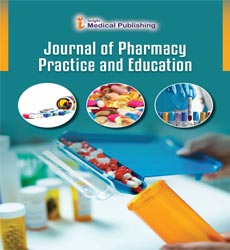A Short note on Zoonosis and it's Diseases
Tanvir Rahman*
Department of Microbiology and Hygiene, Bangladesh Agricultural University, Mymensingh, Bangladesh
- *Corresponding Author:
- Tanvir Rahman
Department of Microbiology and Hygiene,
Bangladesh Agricultural University, Mymensingh,
Bangladesh,
E-mail: tanvirrahman786@bau.edu.in
Received: February 18, 2022, Manuscript No. IPPPE-22-11766; Editor assigned: February 21, 2022, PreQC No. IPPPE-22-11766 (PQ); Reviewed: March 07, 2022, QC No. IPPPE-22-11766; Revised: March 11, 2022, Manuscript No. IPPPE-22-11766 (R); Published: March 18, 2022, Invoice No. IPPPE-22-11766
Citation: Rahman T (2022) A Short note on Zoonosis and its Diseases. J Pharma Prac Edu Vol.5 No.1
Description
A zoonosis is an irresistible sickness brought about by a microbe, an irresistible specialist, like a bacterium, infection, parasite, or prion that has bounced from a creature generally a vertebrate to a human. Regularly, the principal contaminated human sends the irresistible specialist to undoubtedly another human, who, thus, taints others. Zoonoses have various methods of transmission. In unmediated zoonosis, the infection is directly spreaded from creatures to people through media like air (flu) or through nibbles and spit (rabies). Conversely, transmission can likewise happen through a halfway species (alluded to as a vector), which convey the infection microorganism without becoming ill. At the point when people contaminate creatures, it is called invert zoonosis or anthroponosis. The term Zoonosis signifies "creature affliction". A main consideration adding to the presence of new zoonotic microbes in human populaces is expanded contact among people and untamed life. This can be caused either by the infringement of human action into wild regions or by the development of wild creatures into spaces of human action. An illustration of this is the outburst of the Nipah virus infection in peninsular Malaysia in 1999 when serious pig cultivating started on the environment of contaminated natural product bats. An unidentified disease of the pigs enhanced the power of contamination, in the long run communicating the infection to ranchers and causing 105 human passings [1].
Classifications of Zoonotic Diseases
Zoonotic infections are brought about by a wide scope of microorganisms. In view of etiology, zoonoses are characterized into:
• Bacterial zoonoses (like Bacillus anthracis, salmonellosis, tuberculosis, Lyme infection, brucellosis, and plague)
• Viral zoonoses (like rabies, AIDS, Ebola, and avian flu).
• Parasitic zoonoses (like trichinosis, toxoplasmosis, trematodosis, giardiasis, jungle fever, and echinococcosis).
• Parasitic zoonoses (like ringworm).
• Rickettsial zoonoses (Q-fever), chlamydial zoonoses (psittacosis).
• Mycoplasma zoonoses (Mycoplasma pneumonia disease).
• Protozoal zoonoses and illnesses brought about by acellular non-viral pathogenic specialists, (for example, contagious spongiform encephalopathies and distraught cow sickness).
Causes
The rise of zoonotic infections began with the training of creatures. This transmission can happen in any circumstances wherein there is contact with or utilization of creatures, creature items, or creature subordinates. This can happen in a companionistic (pets), monetary (cultivating, exchange, butchering, and so forth), savage (hunting, butchering, or burning-through wild game), or exploration setting [2].
Defilement of food or water supply
Food goes about as a significant medium to pass on pathogens known as food-borne pathogens which ordinarily cause diarrheal sicknesses. Numerous food-borne diseases are brought about by zoonotic microorganisms. Food-borne microbes can cause huge grimness and mortality in grown-up and pediatric populaces. Mortality, which impacts millions, is frequently connected with diarrheal infections brought about by sullied food and drinking water [3].
Cultivating, farming and animal cultivation
Contact with livestock can prompt infection in ranchers. Glanders fundamentally influences the individuals who work intimately with ponies and jackasses. Close liaison with cows can prompt cutaneous Bacillus anthracis contamination, while inward breath Bacillus anthracis disease is more normal for laborers in slaughterhouses, tanneries and fleece factories. Close contact with sheep who have as of late conceived an offspring can prompt clamydiosis, or enzootic early termination, in pregnant ladies, just as an expanded danger of Q fever [4].
Pets
Pets can send various infections. Canines (dogs) and felines (cats) are regularly inoculated against rabies. Pets can likewise send ringworm and Giardia, which are endemic in both creature and human populaces. Toxoplasmosis is a typical contamination of felines; in people, it is a gentle illness despite the fact that it very well may be hazardous to pregnant ladies. Toxocariasis is a disease of people of any types of roundworm, including speciesexplicit to the canine or the feline.
Conclusion
Most of the human irresistible infections have creature beginnings. These microbes don't just purpose illnesses in creatures, yet they likewise represent a genuine danger for human wellbeing. Much of the time the adjusted food propensity, environmental change, and earth antagonistic human tasks impact the rise and reappearance of numerous zoonotic illnesses in view of the expanded contact among people and wild creatures. The staggering effect of zoonosis on the human populace is obvious from the current COVID-19 pandemic. Due to the solid interrelatedness among creatures, people, and climate; research zeroing in on the one wellbeing approach should be focused on distinguishing basic intercession steps in the transmission of microbes. Hearty dynamic reconnaissance focusing on all parts of the one wellbeing approach should be carried out to ahead of schedule and precisely recognize zoonoses, so powerful control measures could be taken.
References
- Hubálek Z (2003) Emerging human infectious diseases: Anthroponoses, zoonoses, and sapronoses. Emerg Infect Dis 9:403–404
- Bae SE, Son HS (2011) Classification of viral zoonosis through receptor pattern analysis. BMC Bioinform 12:96-97
- Morand S, McIntyre KM, Baylis M (2014) Domesticated animals and human infectious diseases of zoonotic origins: Domestication time matters. Infect Genet Evol 24:76-81
- Pearce-Duvet JM (2006) The origin of human pathogens: Evaluating the role of agriculture and domestic animals in the evolution of human disease. Biol Rev 81:369–382
Open Access Journals
- Aquaculture & Veterinary Science
- Chemistry & Chemical Sciences
- Clinical Sciences
- Engineering
- General Science
- Genetics & Molecular Biology
- Health Care & Nursing
- Immunology & Microbiology
- Materials Science
- Mathematics & Physics
- Medical Sciences
- Neurology & Psychiatry
- Oncology & Cancer Science
- Pharmaceutical Sciences
